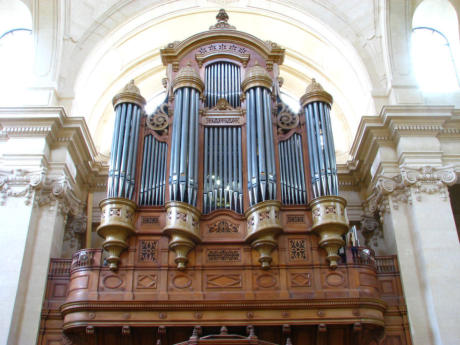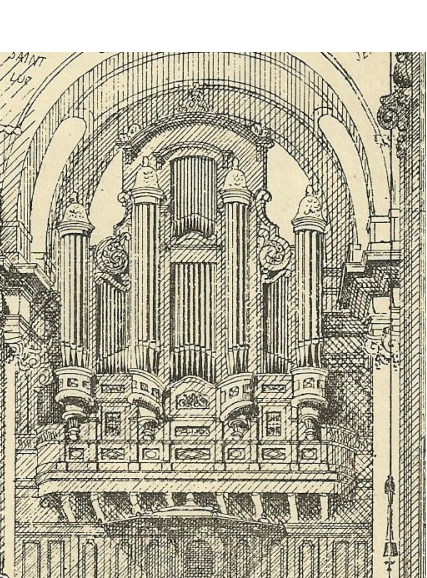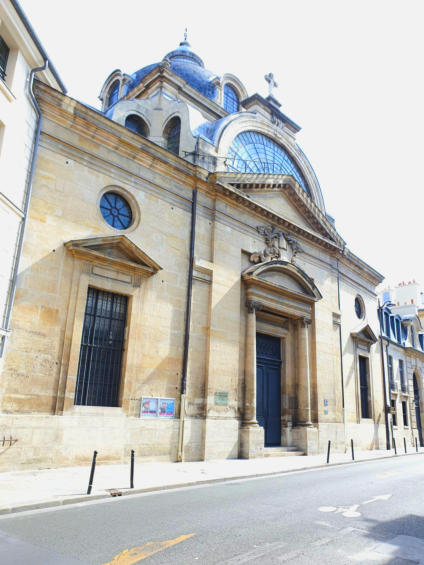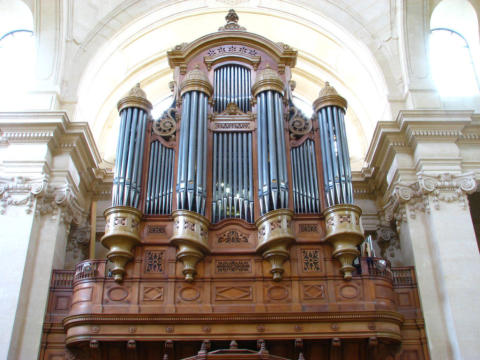


ORGANS OF PARIS © 2024 Vincent Hildebrandt HOME ALL ORGANS
Eglise Protestante Unie de
Pentemont Luxembourg -
Temple de Pentemont
106, rue de Grenelle, 75007 Paris



C3
The organ case is designed by Victor Baltard, situated
above the pulpit, facing the faithful. The organ was built
by Aristide Cavaillé-Coll in 1846 (21 stops). In 1928, a
major intervention was carried out by Paul-Marie Koenig,
followed in 1935 by works of Victor Gonzalez (he made
among others a new windchest for the Swell). Between
1948 and 1966, Beuchet-Debierre made further
modifications to realize a more neo-classical instrument.
Further works were done by Bougarel in 1967 en Barbéris
in 1987.
In 2011-2014, the organ has been rebuilt with private
funding by Yves Fossaert and Atelier Pellerin & Uys. All
Cavaillé-Coll elements which were still present have been
restored: the blower, the windchest of the Great and the
Pedal and 60% of the pipes. The new organ has 35 stops
and three key boards. A Cor de nuit 8 (pipes of Cavaillé-
Coll) was added by the builder because this stop was
avaible and a Violoncelle 8 (pipes of Cavaillé-Coll) was
reinstalled at the Pedal as existed in 1846. A new second
keyboard 'Grand-choeur' has been made housing the
reeds of the former first keyboard. The third keyboard
houses the Swell, which is completely reorganized. Finally,
a Barker machine has been installed.
Inauguration of the organ in 2014
Temple Pentemont is a former monastery of the
Bernardines (1747). After the revolution, it was
transformed into barracks. Now, it houses the
Department of Veterans Affairs. In 1844, Victor
Baltard isolated the chapel from the other buildings
and the former choir of the Bernardines became the
nave of a Protestant church.


1846 - Cavaillé-Coll (1)
1928 - Koenig (3a)
1935 - Gonzalez (3a)
1948 - Beuchet (6)
1956 - Beuchet (3a)
1967 - Bourgarel (6)
1987 - Barbéris (3b)
2014 - Fossaert (4)
III/36 (35) - traction mécanique -
composition
Organiste titulaire
Isabelle Sebah - titulaire et coordinatrice
Benjamin intartaglia - titulaire
Peter Vizard - titulaire honoraire
Concerts
Occasionnaly
Services with organ
Sunday, 10:30 AM
Videos
Isabelle Sebah
Photo organ case: Pierre Marteau
Organs of Paris
Eglise Protestante Unie
de Pentemont
Luxembourg -
Temple de Pentemont
106, rue de Grenelle, 75007 Paris
ORGANS OF PARIS © 2024 Vincent Hildebrandt ALL ORGANS
C3
The organ case is designed by Victor Baltard, situated above
the pulpit, facing the faithful. The organ was built by Aristide
Cavaillé-Coll in 1846 (21 stops). In 1928, a major intervention
was carried out by Paul-Marie Koenig, followed in 1935 by
works of Victor Gonzalez (he made among others a new
windchest for the Swell). Between 1948 and 1966, Beuchet-
Debierre made further modifications to realize a more neo-
classical instrument. Further works were done by Bougarel in
1967 en Barbéris in 1987.
In 2011-2014, the organ has been rebuilt with private funding
by Yves Fossaert and Atelier Pellerin & Uys. All Cavaillé-Coll
elements which were still present have been restored: the
blower, the windchest of the Great and the Pedal and 60% of
the pipes. The new organ has 35 stops and three key boards.
A Cor de nuit 8 (pipes of Cavaillé-Coll) was added by the
builder because this stop was avaible and a Violoncelle 8
(pipes of Cavaillé-Coll) was reinstalled at the Pedal as existed
in 1846. A new second keyboard 'Grand-choeur' has been
made housing the reeds of the former first keyboard. The
third keyboard houses the Swell, which is completely
reorganized. Finally, a Barker machine has been installed.
Inauguration of the organ in 2014
1846 - Cavaillé-Coll (1)
1928 - Koenig (3a)
1935 - Gonzalez (3a)
1948 - Beuchet (6)
1956 - Beuchet (3a)
1967 - Bourgarel (6)
1987 - Barbéris (3b)
2014 - Fossaert (4)
III/36 (35) - traction mécanique -
composition
Organiste titulaire
Isabelle Sebah - titulaire et coordinatrice
Benjamin intartaglia - titulaire
Peter Vizard - titulaire honoraire
Concerts
Occasionnaly
Services with organ
Sunday, 10:30 AM
Videos
Isabelle Sebah
Photo organ case: Pierre Marteau





















